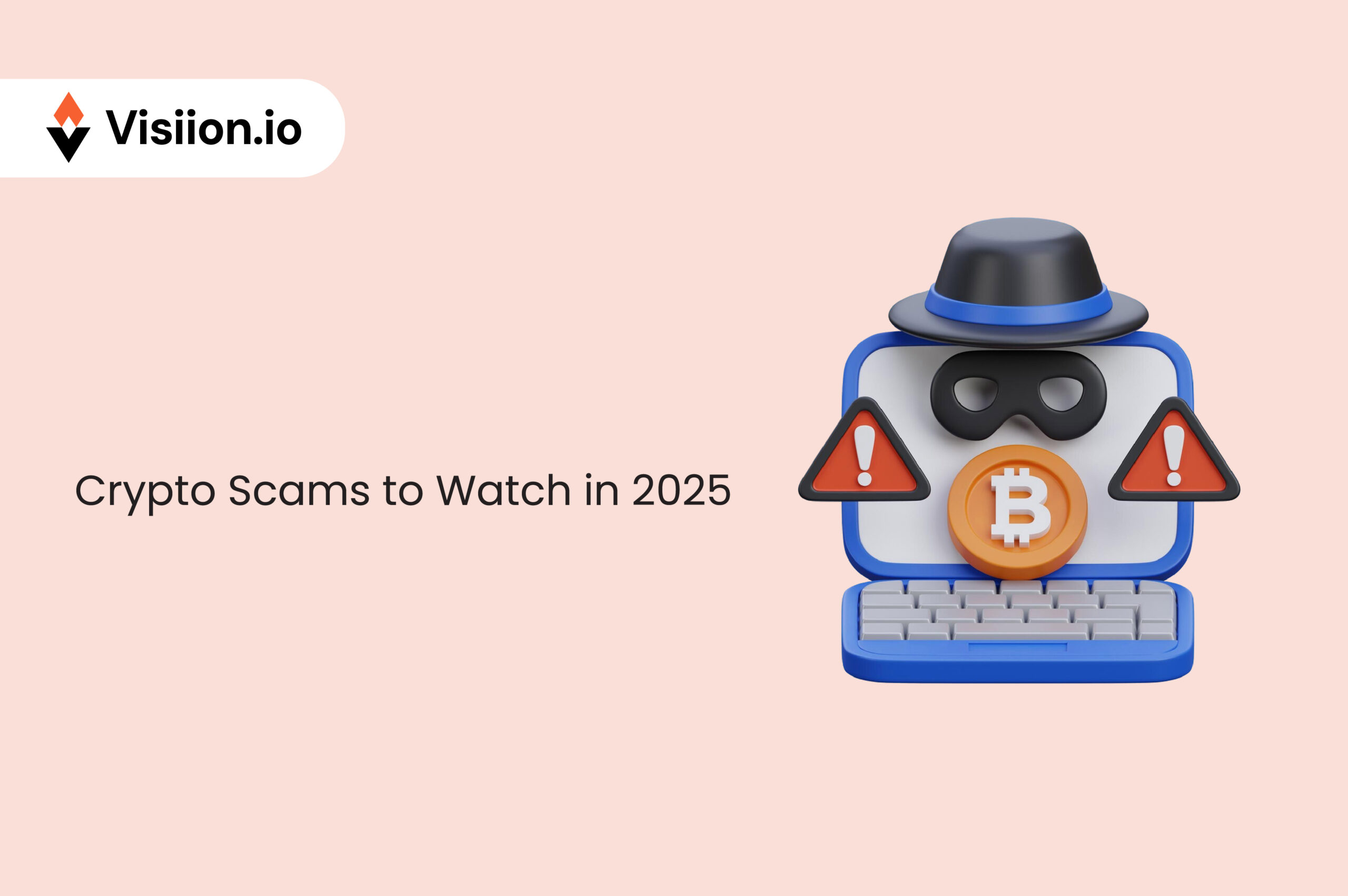Crypto Scams to Watch in 2025
The cryptocurrency market keeps growing. This is drawing millions of investors and traders with promises of high returns. While the opportunities here are immense, there are some inherent risks attached to it, too.
The biggest threat for investors and traders is crypto scams. In 2025, crypto scams are evolving into smarter, sneakier threats that can drain your wallet before you even notice. We bring you the latest on these dangers.
In this blog, we will shed some light on the top crypto scams of 2025 and how you can outsmart them. So, without much ado, let’s start.
Why Crypto Scams Are a Big Threat in 2025?
Cryptocurrency’s decentralized nature and lack of strict regulation create a playground for fraudsters. Add the hype of a potential bull run, and you’ve got a perfect storm. Scammers exploit excitement, fear, and inexperience. Statistics show $2 billion lost to scams and hacks last year alone. That number could climb in 2025 as adoption surges. Knowing what’s out there helps you stay one step ahead.
AI-Powered Phishing Attacks
Phishing scams dominate the crypto scam, and in 2025, artificial intelligence will supercharge them. Scammers craft emails, texts, or social media messages that look identical to legitimate platforms like Coinbase or MetaMask. These messages often urge you to “verify your account” or “claim a reward” with a link. Click it, enter your details, and they’ve got your private keys.
It was reported on March 16, 2025, that a wave of scam emails mimicking Coinbase and Gemini. Scammers tricked users into setting up wallets with pre-generated recovery phrases they already controlled, siphoning funds instantly.
How to Protect Yourself
- Check URLs manually. Legit sites use “https” and match the official domain—like “coinbase.com,” not “coinbase-login.net.”
- Use two-factor authentication (2FA) with apps like Google Authenticator, not SMS. Sangfor notes that SMS-based 2FA risks SIM-swapping attacks.
- Ignore unsolicited messages. No legitimate platform demands your private keys or seed phrases.
Fake Airdrops and Giveaways
Airdrops—free token drops from projects—excite traders, but scammers hijack this hype. They impersonate big names (think Ripple or Elon Musk) and promise to double your crypto if you send them funds first. Or they lure you to phishing sites to “claim” your tokens, only to steal your wallet credentials.
In 2024, Cointelegraph flagged a fake XRP airdrop tied to Ripple’s legal wins. Scammers posed as CEO Brad Garlinghouse, netting thousands via phishing links. Expect more of this in 2025 as projects launch aggressive marketing.
How to Stay Safe
- Verify airdrops on official project websites or X accounts. Ripple warned users directly about fakes.
- Never send crypto to “activate” a giveaway. That’s a dead giveaway (pun intended).
- Use a separate wallet for airdrops. Keep your main funds isolated.
Rug Pulls in DeFi and Meme Coins
Rug pulls hit hard in decentralized finance (DeFi) and meme coin circles. Developers hype a new token, draw in investors, and then vanish with the funds, leaving you with worthless coins. With 2025’s bull run buzz, per KuCoin Learn, expect a flood of these scams.
The “SQUID” token, inspired by Squid Game, surged 40,000% in 2024 before crashing, per KuCoin’s January 2025 report. Scammers cashed out, leaving investors high and dry. Meme coins will likely see similar ploys this year.
Defense Tactics
- Research the team. Anonymous devs raise red flags—check their LinkedIn or past projects.
- Watch liquidity pools. Low or locked liquidity signals a potential exit scam.
- Start small. Test new projects with tiny investments before going big.
Pump-and-Dump Schemes
Pump-and-dump schemes thrive on hype. Scammers boost a low-value coin’s price with fake news or influencer shills, then sell at the peak, crashing the market. Retail traders lose out every time.
Recent Bust
A recent exposé on Jump Trading’s DIO token fiasco showed how they pumped it with influencers, dumped it, and rebought at a discount. Expect tighter coordination via X and Telegram in 2025.
How to Dodge It
- Ignore sudden hype. Check trading volume—spikes without fundamentals scream scam.
- Set stop-loss orders on your platform. Limit losses if prices tank.
- Follow reputable news like CryptoPotato, not random X posts.
Fake Wallets and Exchanges
Scammers clone popular wallets (MetaMask, Trust Wallet) or exchanges (Binance, Kraken) to trick you into depositing funds. Once you do, they lock you out or drain your account. In 2025, these fakes get slicker with polished apps and sites.
OSL.com warned in March 2025 about counterfeit wallet apps mimicking legit ones and stealing keys via backdoors. A UK case from 2024 saw £6 million nabbed via a fake Blockchain.com site, per CryptoNews.
Protection Steps
- Download only from official sources—app stores or project sites.
- Check reviews and ratings. Low downloads or sketchy feedback? Steer clear.
- Test with small transfers first. Confirm the platform works before committing big.
Social Media Impersonation
Scammers love X, YouTube, and Telegram. They pose as influencers, support staff, or celebs, offering “exclusive tips” or “tech help.” They’ll direct you to fake sites or ask for your keys outright.
A report by Cointelegraph in February 2025 piece on meme coin scams noted hacked verified accounts pushing fake presales. A user lost $304,000 in March 2025 after copying a dusting attack address from a scammer’s X post.
Safeguards
- Verify accounts. Look for blue checks and cross-check with official channels.
- Never share keys or phrases. Legit staff won’t ask.
- Block suspicious DMs. Report them to the platform.
Malware and Browser Threats
Malware evolves fast. In 2025, trojans like StilachiRAT—spotted by Microsoft, per a recent post—target Chrome extensions (MetaMask, Coinbase Wallet). They snatch your keys while you browse.
Sangfor warns of infected downloads or phishing links delivering malware. One-click, and your wallet’s compromised.
Countermeasures
- Use hardware wallets (Ledger, Trezor) for big holdings. Keep them offline.
- Update software regularly. Patch vulnerabilities fast.
- Avoid shady links. Stick to trusted sites.
Ponzi Schemes with Trading Bots
Fancy a bot that “guarantees” 13.5% monthly returns? Scammers like the Adam brothers in 2024 peddled fake bots, paying old investors with new money until it collapsed. These resurface in 2025 with flashier promises.
Telltale Signs
- Unrealistic returns. No bot beats the market forever.
- Pressure to recruit. Pyramid vibes mean trouble.
Stay Secure
- Test bots with small amounts. Use your platform’s demo mode if available.
- Skip “too good to be true” offers. Stick to proven tools.
Bonus Threats to Watch
Apart from the ones mentioned above, there are some more crypto scams too that you should watch. These crypto scams are not as notorious but are equally dangerous for your investments.
- Honeypot Scams
Fake tokens trap your funds. Here, you invest thinking you are getting massive value with minimal investment. But ultimately, it proves to be a scam.
- Multi-Sig Wallet Tricks
Scammers exploit shared keys. With this, they steal cryptos from the wallets of investors and traders.
- Job Scams
“Crypto jobs” demanding upfront payments are another menace. As the popularity of cryptos is booming, people think they have great jobs in the field. While it’s true, paying upfront for a job is the biggest scam.
General Tips to Shield Your Wallet
Look, we understand that scammers are constantly evolving. They are finding new techniques every day to steal from you. But with some basic habits, you can reduce your risk a lot. Remember, the biggest threat to a person’s investment and hard-earned money is not crypto scams. The biggest risk is their greed. Don’t fall for “too good to be true” strategies and plans. Moreover, keep the following things in mind:
- Secure Your Keys: Store seed phrases offline—paper or metal backups beat digital files.
- Use Cold Storage: Hardware wallets protect big sums from online hacks.
- Double-check Everything: Addresses, URLs, emails—triple-check before acting.
- Stay Informed: Follow Visiion.io, CoinDesk, or CryptoPotato for real-time alerts.
- Trust Your Gut: If it feels off, walk away.
How Your Trading Platform Helps
A good crypto platform like Visiion.io can boost your defense. We educate our traders and investors about such crypto scams. Remember, your crypto platform should have the following features by default:
- 2FA (2-Factor Authentication) for secured login
- Fast withdrawals to safe wallets.
- Real-time market data to spot pump-and-dumps.
We’ve got your back with these features at Visiion.io. Use them, leverage them and make sure you protect your hard money.
Losing crypto stings. Scammers bank on your FOMO or panic. Take a breath before jumping on “urgent” deals. A clear head beats a rushed mistake every time.
What’s Next for Crypto Security?
Cryptos are rapidly becoming a part of life for the larger global population. So more money will be involved here with each passing day. And where there is a money, it become a target-rich environment for fraudsters to execute their crypto scams. But with the right steps and tools, you can tackle the challenge.
Wrapping Up
Crypto scams in 2025 blend old tricks with new tech—phishing gets AI polish, rug pulls ride DeFi waves, and malware sneaks through browsers. But you don’t need stress to stay safe. Arm yourself with knowledge, lean on solid tools, and keep your wallet locked down. The market’s wild, but your funds don’t have to be at risk. Share this with your trading buddies—let’s keep the community strong and scam-free.







